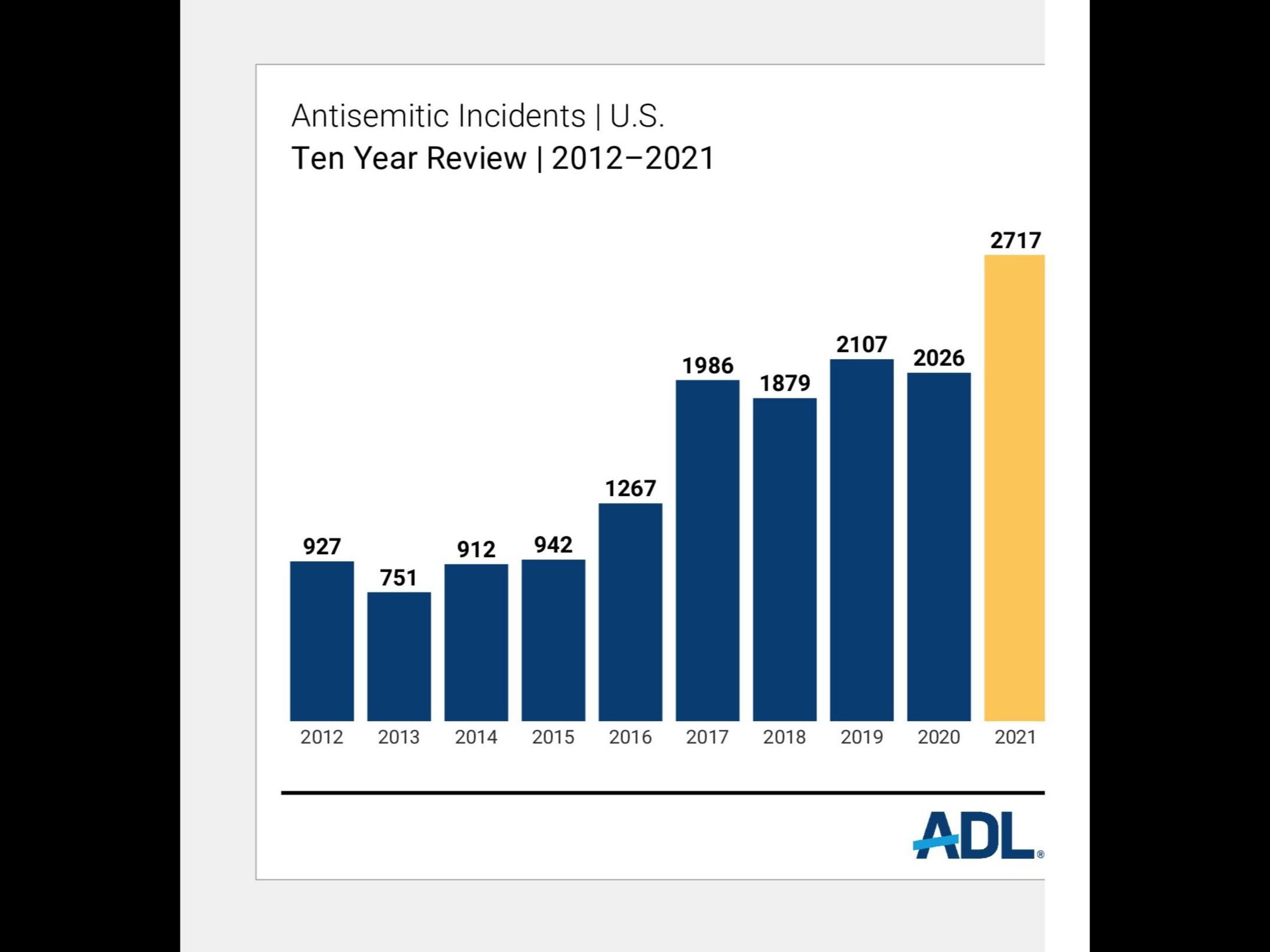Antisemitism: What’s Old is New, and Should Be News Again

Events in California last weekend make tragically clear the vulnerability of Americans in an open society where risks can become threats and then crimes with little warning. But an open society also provides the opportunity to identify the risks and threats before the worst happens. A recent survey by the Antidefamation League accomplishes that task and more by tracking the changes in American attitudes toward the Jewish community that warrant attention from national political leaders and the news media sooner rather than later.
When it comes to antisemitism, it’s sad to say ... but what’s old is new again. A survey this month from the Anti-Defamation League describes the growing number of Americans who subscribe to beliefs spawned by the prejudice. It’s not a surprise. The reasons why are hidden in plain sight.
The ADL’s survey isn’t an outlier. Extremism and the attitudes that underpin it have been well researched for years. So have their consequences. Federal reports have shown a dramatic year-over-year rise in hate crimes since 2016. The findings parallel the Anti-Defamation League’s annual audit of antisemitic acts. Its latest report, released last April, reveals that antisemitic incidents hit their highest level in 2021 since tracking began 40 years ago.
The numbers in the ADL’s audit speak for themselves. The report for 2021 recorded 2717 antisemitic incidents, a 34 percent over the preceding year. Attacks, vandalism and harassment at synagogues, Jewish community centers and schools accounted for 525 incidents -- a 61 percent increase over 2020. Some 88 others were physical assaults. None were fatal, but it wasn’t for lack of trying. Eight used deadly weapons -- a 131 percent rise over 2020.
The reason hate crimes including antisemitic acts have spiked since 2016 as political discourse has degraded isn’t hard to figure out. After all, a presidential candidate who mocked his opponents, normalized profanity and substituted slurs for serious thinking won the election that year. Add his winks and nods, not to mention his "stand back and stand by" message to the Proud Boys. Long isolated on the political fringe, what extremists wouldn’t believe they had a green light to move into the mainstream? In fact, the ADL’s records suggests they did just that.
According to ADL statistics, from Trump’s first presidential campaign through his last year in office antisemitic incidents rose 60 percent (see graphic above). The ADL recorded 1267 incidents in 2016; the total climbed to 2026 in 2020. The ADL took note of the spike shortly after Trump’s election, flagging the fact several perpetrators referred to him by name in their antisemitic acts. It’s not hard to see why. Intended as dog whistles or not, Trump’s own antisemitic tropes as a candidate and as president abounded.
Speaking before a Jewish group in 2015, candidate Trump joshed that Jews might not support him because "they want to control their own politicians." His television spots highlighted the theme. One TV ad just before the election featured images of prominent Jews, Trump’s voice-over stressing they "control the levers of power." As president, Trump continued the march. Reacting to extremists’ attacks on protesters in Charlottesville in 2017, for instance, he acknowledged the "fine people on both sides." In 2018 and 2019 Trump regurgitated another old slur about Jewish allegiances, asserting that Jews who vote against him were "disloyal."
Trump isn’t the only Republican who’s catered to audiences on the extremist fringe. Arizona’s Paul Gosar is well known for repeating far right and white nationalist themes. So is Marjorie Taylor Greene. What difference does it make? Gosar serves in the new Congress on the House Oversight Committee. Taylor Greene sits on the Oversight and Homeland Security Committees. Both were stripped of committee assignments in the last Congress for misbehavior. In addition to playing to their respective galleries as high profile committee members, the two will be on panels charged with investigating the kind of extremism they praise and promote.
The pair and their assignments are good reason for skepticism about whether Republicans will take rising antisemitism seriously. They’re also not the only ones. Tom Emmer, the GOP House majority whip, is on record accusing Mike Bloomberg, Tom Steyer, George Soros and other prominent Jewish leaders as having bought control of Congress for the Democrats. Florida’s Matt Gaetz invited a notorious Holocaust denier to the 2019 State of the Union address. And campaigning last year, J.D. Vance, Ohio’s new senator, invoked George Soros as an alien specter ready to subvert the state’s abortion ban.
Does the GOP’s blind eye turned to rising antisemitism matter? Taken together with the Anti-Defamation League’s annual audits, the ADL’s latest survey of Americans’ beliefs suggest it does. Last fall 4000 people participated in the survey, a collaboration with the University of Chicago and One8 Foundation. Entitled "Antisemitic Attitudes in America," the executive summary put the findings this way.
"Over three-quarters of Americans (85 percent) believe at least one anti-Jewish trope, as opposed to 61 percent found in 2019. Twenty percent of Americans believe six or more tropes, which is significantly more than the 11 percent that ADL found in 2019 and is the highest level measured in decades."
For their part, the news media have dutifully covered the ADL’s latest report. So have several writers including Jennifer Rubin who wrote a fine Washington Post column this week. But the fact the GOP has long ignored extremism in its ranks and among its supporters, antisemitism included, needs to be a far bigger part of the story. Putting extremism’s sympathizers on the congressional committees most important to dealing with its growing threat only underscores the point.
Thanks to the diligence of the ADL, the tally of the ugly deeds and contributing attitudes that the Republican Party’s inaction has helped to engender is a matter of record. Their consequences will be as well, if its leaders fail to take heed.
Click the social buttons to share this story with colleagues and friends.
The opinions expressed here are the author's views and do not necessarily represent the views of MediaVillage.com/MyersBizNet.


